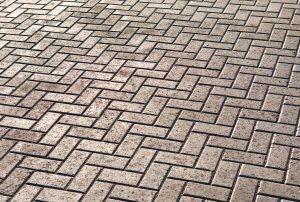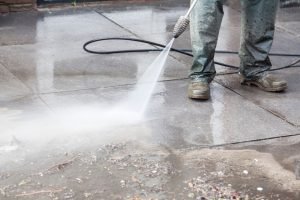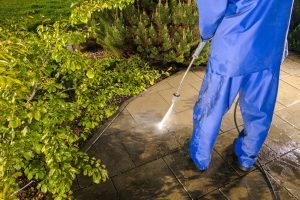Vaughan concrete sealing services can be of great benefit to any property owner. Not only do these services protect against moisture, wear and tear from the elements, but they also extend the life of existing concrete surfaces. By applying a sealant that is designed for specific applications, such as residential driveways or commercial parking lots, owners are able to increase the lifespan and aesthetic value of their concrete structures.
Additionally, there are various options available when it comes to choosing the right type of sealant for your project. This article will provide an overview of what types of sealants are available and how they should be properly applied in order to ensure long-term protection against weathering and deterioration.
The importance of having a sealed surface on your concrete structure cannot be overstated; without proper sealing techniques and materials, water can easily enter into cracks and joints which could cause structural damage over time.
In addition to preventing water penetration, a quality sealer will help minimize staining caused by oil spills or other contaminants while providing enhanced protection from UV rays that cause fading or discoloration. Furthermore, with regular maintenance and reapplication as needed, you can maximize the longevity of your concrete surfaces.
With so many advantages associated with using specialized concrete sealing services, it’s clear why this investment should not be overlooked if you want maximum performance from your existing infrastructure.
Whether you require new installation or restoration work on existing structures, utilizing experienced professionals who utilize industry-leading products and application methods can ensure high-quality results that stand up against the toughest conditions Mother Nature has to offer.
Definition Of Sealing
Sealing concrete is an important step in protecting and maintaining the life of your hard surfaces. It involves a process by which a sealant is applied to areas such as driveways, sidewalks, patios, and other outdoor spaces. This protective layer helps prevent staining from dirt or water, prevents cracking due to freeze/thaw cycles, and preserves its original color for years to come.
The sealing material used depends on what type of surface needs protection. Different types are available depending on the specific application; some feature additional UV protection for outdoor settings exposed to direct sunlight. A professional installer will be able to select the best option based on the intended use.
By taking proactive measures with sealing services, you can ensure that your investment endures while still looking great. Ultimately this leads to higher property value and improved curb appeal of any residential or commercial space.
Benefits Of Sealing Concrete
Sealing concrete is an important step in protecting and preserving the surface. It helps to protect from dust, oil and other spills that may cause deterioration of the surface over time.
Sealing also provides protection against freeze-thaw cycles that can weaken and crack foundation walls, driveways, patios, walkways and other outdoor surfaces. Additionally, sealing helps prevent water penetration which can lead to mold growth or staining on the surface.
Aesthetically speaking, sealed concrete will look better for longer as it resists discoloration caused by dirt, grease and grime build up. Sealers come in a variety of colors so they can enhance the existing look of many different types of concrete surfaces while still providing excellent protection benefits.
In addition to all these benefits, sealers are easy to apply with minimal effort required for maintenance afterwards. With proper application and maintenance routine, a sealed concrete surface could last indefinitely depending on its intended use.
Moreover, sealants prolong the life span of any concrete structure or surface significantly reducing long term costs associated with repair or replacement due to wear and tear damage over time.
The right type of sealer used correctly can ensure that any concrete structure remains soundly protected without compromising aesthetics or functionality for years to come. Transition sentence: In order to maximize these protective properties provided by sealing concrete, understanding what types of sealers are available is essential.
Types Of Sealers
The type of sealer used to protect concrete is an important part of the overall protection plan. To ensure that the right product is selected, it is necessary to understand the different types of sealers available and how they will affect the surface of your concrete.
There are two main categories of sealers for concrete: penetrating and topical. Penetrating sealers penetrate into the pores in the concrete and form a barrier against water, dirt, oils, and other contaminants from entering or damaging the surface.
This provides long-lasting protection without changing the appearance or texture of the surface. Topical sealers are applied on top of existing surfaces as a protective layer, providing a glossy finish while also protecting from damage caused by weathering, abrasion, chemicals, etc. They come in various forms such as acrylics, epoxies, polyurethanes, and silicones; each with its own unique benefits but all offering superior protection compared to untreated concrete.
In addition to these two major categories there are specialty sealers designed specifically for certain applications like stamped concrete or exposed aggregate surfaces. These products may offer additional aesthetic appeal while still maintaining their protective qualities.
With so many options available choosing a suitable sealer can seem daunting but considering your specific needs along with professional advice should help point you in the right direction. With proper selection and application procedures followed sealing will provide effective protection for years to come. The next section looks at selecting a suitable sealer based on your individual requirements.
Choosing The Right Sealer
When it comes to concrete sealing, choosing the right sealer is essential. There are a variety of options available on the market ranging from acrylics and epoxies, to polyurethanes and silicones. Each type of sealer has its own distinct advantages. In order to ensure that you’re making the best choice for your particular project, there are several factors you should consider:
- Durability: How long do you need the sealant to last? Some types of sealers can last up to 25 years or more with proper maintenance while others may only offer short-term protection against weathering elements like UV rays and moisture.
- Application Method: What kind of application method will be necessary in order to apply the sealant correctly? Depending on what material you’re working with, some methods may not work as well as others.
- Cost: How much money are you willing to spend? Different types of sealants come at different price points depending on their composition and quality level.
It’s important that you take all these factors into consideration before selecting which type of concrete sealer is most suitable for your project needs. Researching products thoroughly and speaking with an experienced professional can help make sure that your selection is informed and accurate.
Having this information allows you to select the optimal product that offers both cost savings and superior performance results. With the right sealing solution chosen, preparation for sealing can begin without any further delay.
Preparation For Sealing
Preparation for sealing concrete surfaces is critical to proper application of sealer and a successful outcome. It is important that surface preparation be completed prior to applying the sealer, as inadequate or improper cleaning can lead to poor adhesion and an unsatisfactory finish. The following table outlines the steps required for proper pre-sealing preparation:
| Step | Description |
|---|---|
| 1 | Remove dirt, dust, oil or any other contaminants from surface |
| 2 | Clean with a power washer using hot water |
| 3 | Rinse thoroughly with clean cold water |
| 4 | Allow the area to dry completely before proceeding |
It is essential to remove all impurities including dirt, dust, oil and other contaminants from the concrete surface in order for the sealant to adhere properly. Depending on the degree of contamination, this can be achieved through pressure washing with high temperature hot water followed by rinsing off with cold water. For maximum effectiveness it is important that the area be allowed sufficient time to fully dry out before moving onto the next step.
The thoroughness of these preparatory measures will affect not only initial adhesion quality but also long term durability of the sealed surface. Therefore, taking care during this stage will help ensure better results in terms of appearance and longevity.
To move forward with confidence, one must have assurance that their prep work has been done right – anything less could mean costly repairs down the road. With this in mind, applying a sealer requires careful consideration and attention to detail throughout every phase of its implementation.
Applying The Sealer
Applying the sealer requires precision and attention to detail. When done correctly, it can extend the life of a concrete surface, protect from staining and wear, and enhance its aesthetic appeal. The key is to adequately cover every part of the surface without missing any areas or over-saturating others. To do this, several steps must be taken: selecting an appropriate sealer for the intended purpose; preparing the surface by cleaning and priming if necessary; applying the sealer with an even coat using either a brush, roller or sprayer method; ensuring proper coverage on all surfaces.
Once these steps have been completed, it is important that the sealed surface be allowed sufficient time to cure before use. During this period, certain precautions should be taken in order to ensure that no damage occurs during curing. These include avoiding direct sunlight exposure and preventing water contact as much as possible while allowing airflow around the area being treated. This will allow for optimal drying conditions so that when complete, you are left with a fully cured and protected sealing layer ready for use. Transitioning into our next section about curing the sealed surface we will discuss further how to properly care for your newly applied sealant until it is ready for use.
Curing The Sealed Surface
Curing is an essential step in the sealing process of concrete surfaces. It involves allowing the sealant to harden and bond with the substrate, creating a durable protective layer. Proper curing ensures that the sealed surface can withstand wear-and-tear for an extended period of time without showing signs of decay or degradation. Curing should be done gradually, as rapid drying could lead to cracking or other damage to the sealer due to shrinkage.
The best method for curing will depend on the type of sealer being used, and different methods may require specific temperatures and humidity levels. Generally, it is recommended that freshly applied liquid sealers are allowed to dry naturally over several days at room temperature before any heavy foot traffic is allowed onto the surface. Film forming sealants such as acrylics need even more time (upwards of three weeks) and must be protected from moisture while they are setting up properly.
To ensure that your concrete surface cures correctly and effectively, it is important to follow all instructions provided by your sealer manufacturer regarding application steps and procedures. Failure to do so may result in poor adhesion between the substrate material and the sealer leading to premature failure of both materials. With proper care during this phase, you can achieve a strong foundation for maintaining a sealed concrete surface for years ahead.
Maintaining A Sealed Concrete Surface
Once a sealed concrete surface has been cured, it is important to maintain the sealant in order to ensure longevity. Regular maintenance can help protect against damage from moisture and other elements that could lead to costly repairs. In addition, preventive measures should be taken to avoid potential future issues with the sealed surface.
The first step of maintaining a sealed concrete surface is regular inspection for any signs of wear or damage. This includes checking for cracks, chips, discoloration, and other physical changes in the sealant. If these are noticed, then repair work may need to be done in order to keep the surface protected from further deterioration. Additionally, an occasional cleaning may also be necessary depending on the type of sealant used.
Finally, it is vital to monitor environmental conditions such as rain and freezing temperatures when caring for a sealed concrete surface. Moisture and extreme cold can both create problems with sealants which can cause them to become brittle or crack over time if not addressed promptly. Taking steps ahead of time by using waterproofing products or applying additional layers of protection will go a long way towards ensuring the lasting results desired from sealing services. With proper care and vigilance, one can have confidence knowing their investment into sealing services will last for many years without issue. Transitioning now into common issues with sealed surfaces…
Common Issues With Sealed Surfaces
Sealed surfaces are prone to many common issues. For example, a residential driveway in Houston was sealed with an acrylic sealant that flaked and peeled away after only one year of use. The homeowner had to have the surface re-sealed which cost them both time and money.
Cracking is another issue commonly seen on sealed surfaces. This occurs when there are cracks beneath the surface or due to improper sealing techniques used by contractors. UV exposure can also cause cracking as it breaks down the protective layer over time, allowing water and dirt particles to penetrate the material below. Sealing can help prevent this from happening but if cracking already exists, it’s best to replace the affected area before applying sealant.
Another problem is staining; oil, grease and other substances can make their way into unsealed pavement causing discoloration that can be difficult to remove without professional services for sealing. It’s important to apply a sealant regularly so these stains will not become permanent marks on your concrete surface. With regular maintenance and proper care, sealed surfaces should remain looking like new for years to come. Transitioning seamlessly into professional services for sealing requires knowledge of product types and application processes ensure quality results every time.
Professional Services For Sealing in Vaughan
Professional concrete sealing services provide a range of processes to ensure that concrete remains protected from the elements. Sealing helps protect against water damage and can also help reduce staining, fading, dusting, and efflorescence. In addition, it is important for preventing unsightly cracks in concrete surfaces. Professional service providers are experienced in identifying the most appropriate sealant for each particular application, be it an interior or exterior surface.
The first step in any sealing process is preparation. This includes cleaning the area thoroughly with a pressure washer or chemical cleaner to remove dirt, debris and contaminants such as oil stains. Any existing sealer must also be removed prior to applying a new one. Once this has been done, the contractor will then apply the chosen sealant evenly over the entire surface according to product directions. It’s important that all edges and corners are well sealed so there aren’t any gaps which could allow moisture into the substrate below. Afterward, contractors often recommend waiting several days before walking on or using the area in order to allow ample time for curing and drying of the sealer applied.
It’s essential that professional contractors are hired when undertaking a project involving concrete sealing services as they have access to quality products and equipment needed for a successful job completion. They will advise clients on what type of sealants best meet their needs as well as how frequently maintenance should take place for optimum protection benefits year-round. Additionally, professionals understand how different types of climates affect various materials used during installation thus ensuring optimal results regardless of where projects occur geographically speaking. By hiring experienced professionals customers can rest assured knowing that their home or business’s foundation will stay safe and secure throughout its lifetime thanks to proper sealing techniques employed by knowledgeable experts in the field.
Conclusion
The use of a concrete sealer is an important part of protecting and maintaining the integrity of concrete surfaces. Concrete sealers help protect against water damage, UV rays, chemicals, staining, and dirt. On average, a quality concrete sealer can last up to five years. However, regular maintenance such as resealing every two or three years will ensure optimal protection for your surface.
When it comes to safety considerations, most modern-day concrete sealers are non-toxic and safe to use around humans and animals alike. While sealing does add some degree of waterproofing abilities to the concrete surface, there is still a need for proper drainage in order to avoid future seepage issues. If DIY projects are not your thing then professional installation may be required depending on the amount of area being sealed.
Finally when considering how often one should reseal their concrete surfaces; statistics show that nearly 80% of homeowners wait until visible signs of deterioration appear before resurfacing or resealing their concrete surfaces – which could lead to costly repairs further down the line. Therefore it is recommended that you maintain your investment by regularly inspecting and resealing your surface every 2-3 years at minimum according to manufacturer’s instructions for best results.
Frequently Asked Questions
How Long Does A Concrete Sealer Last?
Concrete sealers are a common choice for protecting and preserving the integrity of concrete surfaces. They provide protection from dust, moisture, chemicals, and other elements that can cause damage to these surfaces over time. But how long does a concrete sealer actually last? The answer may vary depending on many factors such as what type of sealant is used, the environment it’s exposed to, and how often it’s applied.
On average, a high-quality concrete sealer should be able to protect your surface for up to five years with proper maintenance and application. With regular cleaning and reapplication when needed, this lifespan could potentially extend even further. It’s important to note that different types of sealants have various lifespans according to their chemical makeup; some can last up to 15 years while others will not last more than six months in certain conditions.
When selecting a concrete sealer for your project, take into consideration its longevity compared to cost and performance—it might make sense financially in the short term to select cheaper options but if you want lasting results then investing in quality products will pay off in the long run. Additionally, keep an eye out for warranties offered by manufacturers which can help ensure satisfaction with your purchase decision.
Are Concrete Sealers Safe To Use?
Are concrete sealers safe to use? This is an important question for anyone considering using a concrete sealer in their project. Concrete sealing products are generally designed to provide protection from the elements, and these chemicals can have potentially hazardous effects if not used correctly. It’s worth noting that most professional grade concrete sealers contain non-toxic components, making them relatively safe for handling and application.
This being said, it is still recommended that any product be tested before full scale application. Careful attention should also be taken when disposing of unused portions as many products may include toxic ingredients which could cause environmental damage or harm humans and animals if mishandled or disposed of improperly. When applying a sealer, it’s best practice to wear protective gear such as gloves, glasses and a respirator mask to prevent contact with skin or eyes. Taking these precautions will ensure safety during the process of applying a concrete sealer.
In addition to following directions carefully, proper ventilation must always be ensured while using concrete sealers; this type of chemical product has volatile organic compounds (VOCs) which can lead to air quality issues without proper ventilation control measures in place. Once applied according to directions provided by the manufacturer, you can rest assured knowing your newly sealed surface is now shielded from the weather and protected against further deterioration due to water penetration and other external factors usually caused by exposure over time.
Is There A Difference Between Sealing And Waterproofing Concrete?
The difference between sealing and waterproofing concrete is a question that has been the subject of debate for years. Take, for example, the case study of a homeowner who is renovating their basement. They know they need to protect their investment from water damage but are unsure if sealing or waterproofing would be best. To answer this question, it’s important to understand how each process works and what benefits they offer.
Sealing concrete involves applying a sealant to the surface in order to prevent moisture penetration while preserving its appearance. This protects against staining and degradation caused by exposure to water and other elements over time. Sealing also helps reduce cracking due to temperature changes as well as efflorescence – white residue left behind when salts leach out of masonry materials such as mortar or grout. The downside is that sealed surfaces can still become wet; however, this type of protection generally lasts two to three years before needing reapplication.
Waterproofing concrete, on the other hand, goes beyond just preventing water infiltration. It provides an extra layer of protection against potential flooding by creating an impermeable barrier below the surface that prevents any water from passing through. In addition, it strengthens the structure itself by filling cracks and preventing further deterioration due to weather conditions or other factors such as ground movement/shifting soil underneath footings/foundations etc.. While more expensive than simply sealing concrete, waterproofing offers superior long-term performance with minimal upkeep required after its initial installation.
When deciding whether to seal or waterproof your concrete surfaces, it’s important to think about your individual needs and budget constraints so you can choose the option which will provide you with maximum benefit at minimum cost. Taking into account both short term and long-term results should help ensure you pick the right solution for your particular project requirements.
How Often Should I Reseal My Concrete Surface?
It is often said that an ounce of prevention is worth a pound of cure. When it comes to concrete surfaces, this adage could not be truer. Regular resealing and maintenance can help ensure the longevity of any concrete surface and prevent costly repairs down the line. This begs the question: How often should one reseal their concrete surface?
The frequency at which you should reseal your concrete depends on several factors such as climate, usage and exposure to chemicals. Generally speaking, most exterior concrete surfaces will need to be sealed every two years or so in order to keep them looking their best, while interior surfaces may only need sealing once every three to five years depending on how frequently they are used. If your area receives frequent rainfall or snowfall throughout the year, you may even want to consider increasing the frequency with which you seal your outdoor surfaces for added protection against the elements.
When assessing when it’s time for a new coat of sealer on your concrete surfaces, look out for signs like fading or discoloration, chipping paint or cracks appearing in the surface – all of these can point towards needing another layer of sealant applied before too long. Whether indoors or outdoors, taking regular steps toward upkeep and preventative care can go a long way in preserving your valuable assets for many years to come.
By taking proactive measures now rather than waiting until damage has already been done, homeowners and businesses alike can rest assured that their investment into concrete sealing services will pay dividends over time – guaranteeing beautiful results far into the future.








